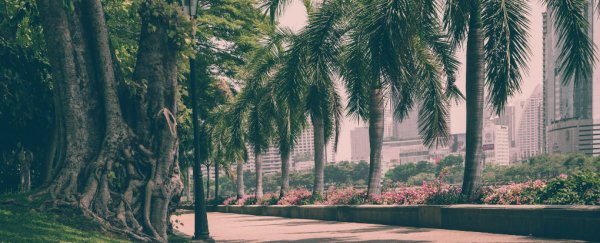NASA's scientists don't spend all of their time gazing up at the stars, and one of the agency's latest studies to date concerns the essential role that foliage plays in keeping our cities cool. Trees and plants not only offer somewhere to sit in the shade on a sunny day, they affect the overall temperature of a city at its surface, which is something to think about the next time you're considering moving neighbourhoods.
This is partly due to a process called evapotranspiration: trees release water vapour in a similar way to humans releasing sweat, through the stomata (or pores) of their leaves and stems. This is a well-known process, but the NASA study takes this further to examine how it might affect the urban temperature compared with the environment that surrounds it.
Using satellite data and temperature sensing equipment, the researchers found that urban areas with at least 65 percent foliage cover stay a constant 1.3˚C above the surrounding area. When this figure dips below 65 percent, the temperature starts climbing, and once it's down to 35 percent, the temperature increase is an average of 1.6˚C.
When you consider that a rise of one degree can lead to a 20 percent increase in the use of air conditioning units, it's easy to see the dramatic effects vegetation can have on a city's power use.
The study used data from the whole of the continental United States, and (as you would expect) found that the difference is most marked during the day when the Sun's rays are strongest. Another discovery was that in smaller cities the temperature difference was less pronounced than it is in larger ones.
Built-up urban areas are traditionally thought of as heat islands, with impervious surfaces - roads, buildings, concrete, and so on - retaining a lot of the sun's heat. The NASA report shows what a significant impact tree-lined streets can have on these city heatsinks, and in areas of desert a tree-filled urban space can actually lower the temperature when compared to its immediate surroundings - thanks to tree cover and irrigation that otherwise wouldn't be in place.
"Everybody thinks, 'urban heat island, things heat up'," explained report co-author Kurtis Thome in a press release. "But it's not as simple as that. The amount and type of vegetation plays a big role in how much the urbanisation changes the temperature."
Thome and his colleagues are hoping their data will help urban planners work out a better way of incorporating trees and other vegetation as natural cooling aids in the cities of the future.
